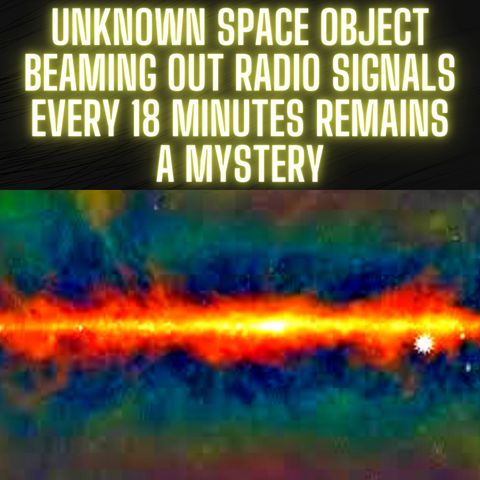Mysterious object just 4,000 light years away from Earth releases a giant burst of energy three times an hour

Regístrate gratis
Escucha este episodio y muchos más. ¡Disfruta de los mejores podcasts en Spreaker!
Descarga y escucha en cualquier lugar
Descarga tus episodios favoritos y disfrútalos, ¡dondequiera que estés! Regístrate o inicia sesión ahora para acceder a la escucha sin conexión.
Descripción
Mysterious object just 4,000 light years away from Earth releases a giant burst of energy three times an hour – and is unlike anything astronomers have seen before Mysterious object...
mostra másMysterious object unlike anything ever seen in space discovered by astronomers
'Spooky' item was observed releasing a giant burst of energy three times an hour
For one minute in every 20 the discovery is one of brightest objects in night sky
Object may be a neutron star or a white dwarf with ultra-powerful magnetic field
A mysterious object that is just 4,000 light years away from Earth is unlike anything ever seen before in space, astronomers have said.
They think it could be a neutron star or a white dwarf – collapsed cores of stars – with an ultra-powerful magnetic field, also known as a magnetar.
As it spins through the cosmos, the 'spooky' object sends out a beam of radiation, and for one minute in every 20 it is one of the brightest objects in the night sky.
Observations show it releasing a giant burst of energy three times an hour.
Astrophysicist Dr Natasha Hurley-Walker, from the Curtin University, International Centre for Radio Astronomy Research (ICRAR) in Australia, led the team that made the discovery.
Her team was mapping radio waves in the universe when they came across the potential 'magnetar'.
She said: 'This object was appearing and disappearing over a few hours during our observations.
'That was completely unexpected. It was kind of spooky for an astronomer because there's nothing known in the sky that does that.
'And it's really quite close to us — about 4,000 light years away. It's in our galactic backyard.'
Dr Hurley-Walker added that the observations match a predicted astrophysical object called an 'ultra-long period magnetar'.
'It's a type of slowly spinning neutron star that has been predicted to exist theoretically,' she said.
'But nobody expected to directly detect one like this, because we didn't expect them to be so bright.
'Somehow it's converting magnetic energy to radio waves much more effectively than anything we've seen before.'
Curtin University Honours student Tyrone O'Doherty discovered the object using the Murchison Widefield Array (MWA) telescope in outback Western Australia.
He said: 'It's exciting that the source I identified last year has turned out to be such a peculiar object.
'The MWA's wide field of view and extreme sensitivity are perfect for surveying the entire sky and detecting the unexpected.'
Objects that turn on and off in the universe are not new, and astronomers call them transients, with some appearing over the course of a few days and disappearing after a few months, and others flashing on and off within milliseconds or seconds.
However, ICRAR-Curtin astrophysicist and co-author Dr Gemma Anderson said finding something that turned on for just a minute made the new discovery unusual.
WHAT ARE NEUTRON STARS?
Neutron stars are the collapsed, burnt-out cores of dead stars.
When large stars reach the end of their lives, their core will collapse, blowing off the outer layers of the star.
This leaves an extremely dense object known as a neutron star, which squashes more mass than is contained in the sun into the size of a city.
A neutron star typically would have a mass that's perhaps half-a-million times the mass of the Earth, but they're only about 20 kilometres (12 miles) across.
A handful of material from this star would weigh as much as Mount Everest.
They are very hot, perhaps a million degrees, highly radioactive, and have incredibly intense magnetic fields.
This makes them arguably the most hostile environments in the Universe today, according to Professor Patrick Sutton, head of Cardiff University's gravitational physics department.
The dense objects, in particular their cores, are key to our understanding of the universe's heavy elements.
The mysterious object that has just been discovered could also be a magnetar, which is an incredibly magnetic neutron star.
Información
| Autor | Gawid Entertainment Podcasts |
| Organización | Gawid Entertainment |
| Página web | - |
| Etiquetas |
Copyright 2024 - Spreaker Inc. an iHeartMedia Company
